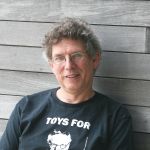
Andrew Murray
We use budding yeast in three different ways: 1) to experimentally evolve novel traits, such as multicellularity and circadian clocks, 2) to test our understanding of interesting biological traits by trying to engineer them, and 3) to dissect the regulation of cell biologically interesting processes like polarization, energy homeostasis, and the regulation of the cell cycle.
Harvard University
NorthWest Building, Room 496.20
52 Oxford Street
Cambridge, MA 02138
Tel: 617-496-1350
Email: awm@mcb.harvard.edu
Website:
https://murraylab.fas.harvard.edu/
Lab Size: Between 10 and 15
Summary
We try to understand the “rules of the game” that explain how cells function and evolve. We study budding yeast, using experimental evolution, genetic analysis, synthetic biology, and cell biology. We try to make quantitative measurements that discriminate amongst different classes of models. Members of the lab come from both biology and physics backgrounds.
How does biological novelty evolve? Because we lack time travel, this process is difficult to study in nature, and we therefore apply selective pressure in the laboratory. We have evolved multicellularity, altered mating preferences, circadian oscillators, genetic instability, and new connections between signaling pathways and have developed methods to find the mutations that cause these new phenotypes. We are interested both in general questions about what determines evolutionary trajectories and the specific mechanisms that organisms invent to produce novel traits.
How do cells accomplish specific tasks and how did these solutions evolve? We follow the Feynman principle of “What I cannot create, I cannot understand” by engineering and analyzing the behavior of new yeast strains. As examples, we have used synthetic biology to support the notions that the efficient use of secreted public goods drove the evolution of multicellularity, that multicellularity arose before cellular differentiation, and that novel symbioses could arise without requiring previous evolutionary co-adaptation.
How do cells respond and adapt to their environment to maximize the chance that they survive and reproduce? Achieving these aims requires the coordination of thousands of reactions under a wide range of inter- and extracellular conditions. We are exploring how yeast cells respond to sudden starvation and have discovered that they can rapidly halt their cell cycles, at any stage, and then, later, slowly resume cell division. We are asking how they arrest, whether the arrest destabilizes the genome, and how cells adapt to start dividing again.
Finally, we collaborate with David Nelson (Physics) to combine theory and experiment to investigate population dynamics and evolution in space and time.
Publications
Hom, F.Y. and Murray, A.W. Niche Engineering Demonstrates a Latent Capacity for Fungal-Algal Mutualism. Science, 345, 94-98.
Müeller, M.J., Neugeboren, B.I., Nelson, D.R., and Murray, A.W. Genetic drift opposes mutualism during spatial population expansion. Proc Natl Acad Sci U S A. 2014. 111, 1037-42. PMCID: PMC3903240
Huberman, L.B. and Murray, A.W. Genetically engineered transvestites reveal novel mating genes in budding yeast. Genetics. 2013. 195,1277-90. PMCID: PMC3832273
Koschwanez, J.H., Foster, K.R., and Murray, A.W. Improved use of a Public Good Selects for the Evolution of Undifferentiated Multicellularity. eLife. 2013. PMCID: PMC3614033
Lau, D.T. and Murray, A.W. Mad2 and Mad3 cooperate to arrest budding yeast in mitosis. Curr Biol. 2012. 22,180-90. PMCID: PMC3277655
